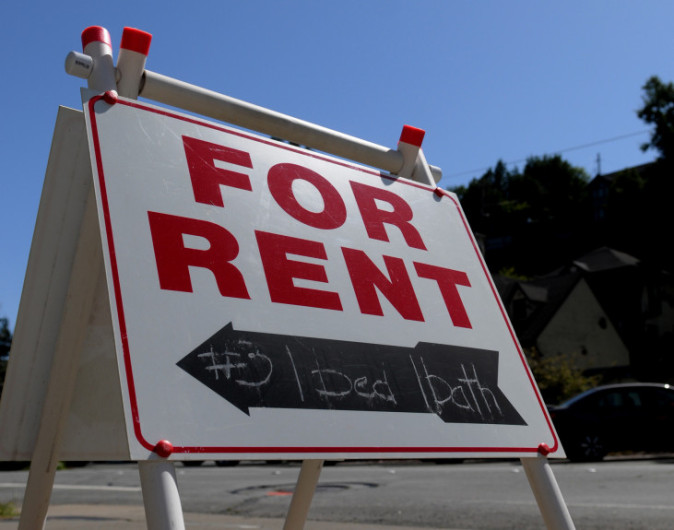PUBLISHED: | UPDATED:
SACRAMENTO — Apartment dwellers and other tenants may soon see relief from steep rent hikes thanks to a landmark deal California Gov. Gavin Newsom reached Friday on legislation that would cap how rapidly rents can rise.
In a boon to tenants, the deal caps annual rent increases at 5%, plus inflation, with a maximum of 10% per year. That’s a lower threshold than the 7% lawmakers had previously negotiated amid strong opposition from the real estate and development industries. Staff members from San Francisco Democratic Assemblyman David Chiu’s office shared with this news organization details of the amended bill which have not yet been formally disseminated.
The bill must still be approved by both houses of the Legislature, which adjourns in two weeks, and signed by the governor before it becomes law. But proponents say it is now looking more likely the legislation will be approved. It comes at the end of a contentious legislative session, which was marked by early optimism among Democratic legislators about making significant progress to address the state’s housing shortage that then began to fade when many of those bills fall apart.
Progress on the rent cap bill, however, marks a victory for tenants who say they are being priced out as rents rise, although many tenants’ rights groups have said there is still much more that needs doing to fully protect tenants from rapidly escalating rents and widespread evictions. Chiu, the bill’s author, had made numerous concessions to the real estate and development industries even to get the bill to the state Senate. But he said in an interview Saturday the deal struck by the governor was very similar to the one he initially proposed, while still balancing the interests of real estate developers and property owners.
“We are in the most intense housing crisis in our state’s history,” he said. “We have millions of Californians who are living paycheck-to-paycheck and are one rent increase away from being forced out of their homes and becoming homeless.”
He added, “This bill will protect millions of Californians from egregious rent increases and predatory evictions, while providing landlords and the rental housing industry with the opportunity to make a fair rate of return.”
In an email, Debra Carlton, senior vice president for public affairs for the California Apartment Association, said her organization would not oppose the bill. But other real estate groups said they would continue to fight it.
“The proposed version of (the bill) headed to the senate floor will not incentivize production of rental housing or help more people find an affordable place to live,” California Association of Realtors President Jared Martin said in a statement Saturday. “It discourages new rental housing, which is why C.A.R., representing more than 200,000 real estate agents and brokers across California, strongly opposes it.”
The bill exempts new apartments built within the past 15 years from the rent cap on a rolling basis, up from a period of 10 years proposed in earlier iterations. Other changes to the bill include a longer sunset period of 10 years, as opposed to three and inflation costs determined on a regional basis, meaning the costs could increase at different rates in San Francisco than in the Central Valley. Single family homes, except those owned by large corporations, are exempt.
Voters last year rejected a ballot measure that would have allowed cities and counties more flexibility in how to implement rent control, by removing provisions in California law that exempt single family homes and apartments built after 1995. Backers of the ballot measure threatened to mount another campaign if lawmakers didn’t act. It wasn’t immediately clear if they were satisfied with Newsom’s proposal, which would not change that state law.
Michael Lane, the deputy director of SV@Home, likened the state’s housing shortage to a natural disaster and the rent caps to the same anti-gouging measures that are often instituted following a major fire or earthquake.
“In this case, we have a housing affordability crisis, so we think it’s appropriate to take this kind of measure,” he said. “It’s an historic breakthrough that strikes the perfect balance between the interests of real estate investors and tenants.”
SV@Home was part of a coalition of private companies, nonprofits and politicians called the Committee to House the Bay Area, or CASA, that is taking a three-pronged approach to addressing the housing crisis: advocating for tenant protections, the production of housing at all levels of affordability, and the preservation of already-affordable housing. There’s still more work to be done to address the state’s severe housing shortage, Lane said.
California needs to build about 180,000 new homes each year to meet the demand for its nearly 40 million people. But the state has averaged only 80,000 new homes in each of the last 10 years, according to a report from the California Department of Housing and Community Development.
Lawmakers this year proposed a number of bills that would have addressed the shortage, but many failed to pass. The much-watched Senate Bill 50 would have allowed fourplexes in neighborhoods where only single-family homes currently are allowed, and forced cities to approve taller, denser condo and apartment buildings near transit stops, but it died in committee. Its author, state Senator Scott Wiener, D-San Francisco, has vowed to resurrect it for a third time next year.
But other bills did advance on Friday, including ones to streamline the approval process for projects that comply with local zoning rules, to make it easier to build on surplus public land and to remove barriers to “granny” or in-law units.
“We need to move forward on all fronts simultaneously to address the production of 3.5 million units of new housing, the preservation of affordable housing and the protection of millions of tenants,” Chiu said. “As soon as this session is done, we will be back at it, looking for the most significant ideas to accomplish all of these simultaneously.”
The Associated Press contributed to this report.

